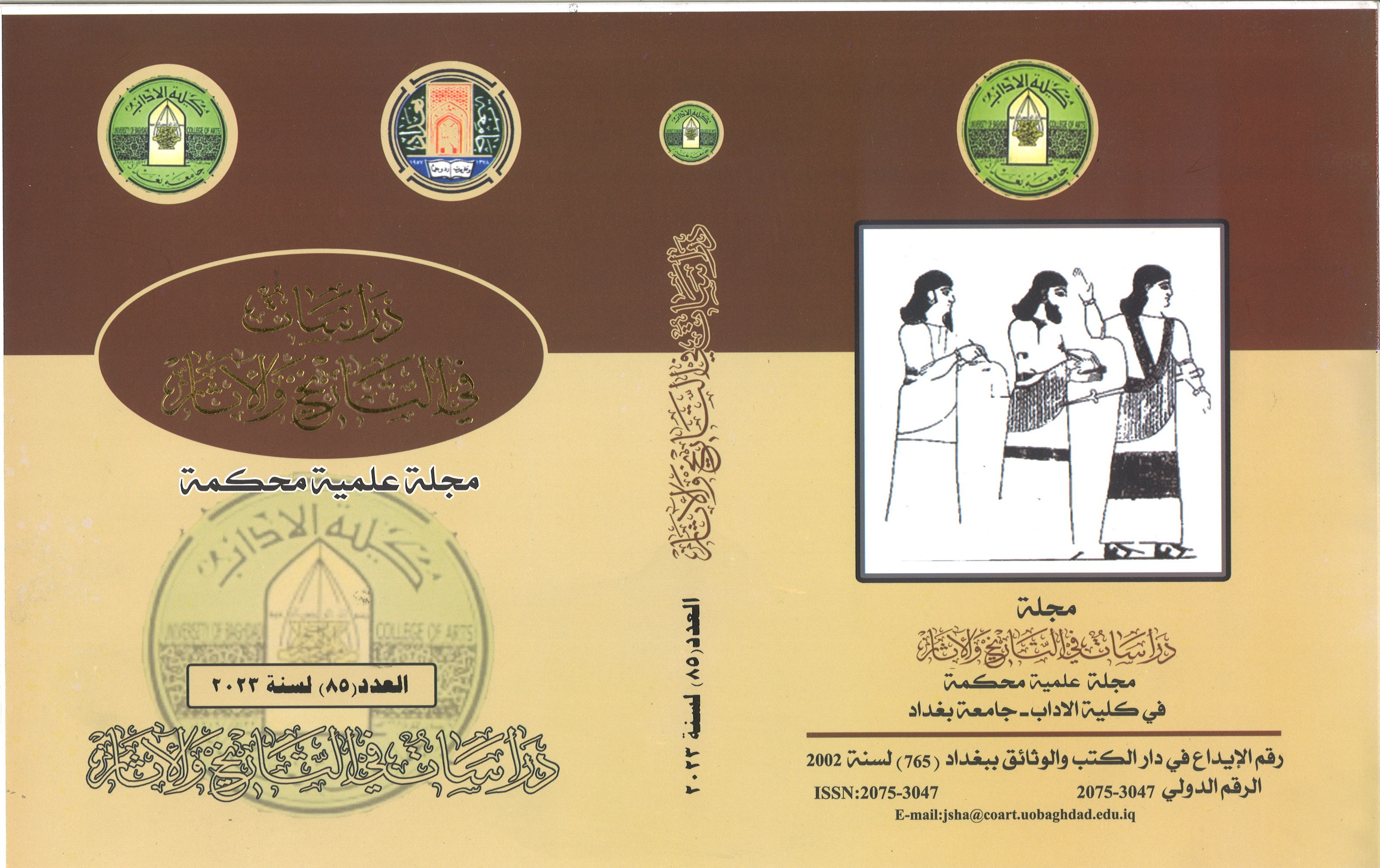الصناعات الزجاجية في ضوء المصادر المدونة في بلاد الرافدين
الكلمات المفتاحية:
الصناعات الزجاجية، مصادر، بلاد الرافدينالملخص
تم العثور على الكثير من المصادر المدونة التي تلقي الضوء على صناعة مهمة وهي صناعة الزجاج في بلاد الرافدين ومن خلال هذه الدراسة توصلنا الى الأمور الأتية:-
- تعدد النصوص المسمارية التي تذكر نسب ومكونات صناعة الزجاج حيث ذكرت النصوص المسمارية الوصفات والنسب الخاصة بتصنيع الزجاج الملون والمواد المستخدمة لصناعة الزجاج وبالأسلوب المتبع آنذاك ويجب ان تكون هذه المكونات ذات نسب معينة للحصول على زجاج جيد.
- ذكرت النصوص المسمارية المكونات والنسب في كيفية الحصول على زجاج في لون معين ( كالأزرق ولأحمر والأخضر ) وغيرها من الألوان .
- تعددت النصوص المسمارية التي تذكر طرائق صناعة الزجاج والخطوات المتبعة للحصول على العجينة الزجاجية كما تذكر النصوص المسمارية الأفران المستعملة في صناعة الزجاج .
- تنوع الأدوات التي وردت في النصوص الاقتصادية منها أدوات معدنية وأدوات متنوعة .
- ورد في العيد من النصوص المسمارية خلطات تزيين الأواني الزجاجية بالألوان الزاهية وذلك الحلي المصنوعة من مادة الزجاج والتي لايكاد يخلو منها موقعاً اثرياً لاسيما العصور التاريخية المتأخرة .
المراجع
- أبا ذر راهي سعدون الزيدي. (2018). موقع المدينة السومرية اريساكرك (الشراكي) "دراسة في ضوء النصوص المسمارية". بغداد: مجلة دراسات في التاريخ والآثار، العدد 65،.
- حسين محمد راضي. (2020). كيمياء الالوان وتطبيقاتها الصناعية في بلاد الرافدين. بغداد: جامعة بغداد كلية الاداب - رسالة ماجستيرغير منشورة , قسم التأريخ .
- حنون عطية عبد الرحيم و اثير احمد حسين. (1985). فن التزجيج في تجميل الواجهات الجدارية في العراق القديم. ميسان: جامعة ميسان - كلية التربية - قسم التاريخ - العدد 58.
- قحطان رشيد. (1987). الكشاف الاثري في العراق. بغداد.
قصي صبحي عباس. (2009). فن وصاعة التزجيج في العراق القديم دراسة تحليلية في ضوء الادلة الاثرية. بغداد: مجلة دراسات في التاريخ والاثار - العدد 12 جامعة بغداد كلية الأداب قسم الاثار.
- مهدي موسى العلاق. (بلا تاريخ). دراسة تاريخية لتطور صناعة الزجاج.
- وليد الجادر. (1972). الحرف والصناعات اليدوية في العصر الاشوري المتأخر. بغداد.
- Brill, R. H. (1972). Some Chemical Observations on the Cuneiform Glassmaking Texts,” Annales du 5e Congrès de l’Association Internationale pour l’Histoire du Verre.
- CDA. (بلا تاريخ).
D.I Owen. (بلا تاريخ). "Cuneiform Texts Primarily from Iri-sağrig/ Āl-10- Šarrāki and The History of The Ur III Period". NISABA.
-Thurean- Dangin, F.(1903) Recueil Destablettes Chaldennes ., paris.
- Oppenheim, L. (1970). Glass and Glass making in Ancient Mesoptamia. New York.
- Shiyanthi Thavappalan, J. S. (2016). Jens Strenger and Snow, Color and Meanthing Ancient Mesopotamia. The Case of Egyptian Blue ZA, Band.
- Thompson. (1936). A Dictionary of Assyrian Chemistry and Geology. Oxford.
التنزيلات
منشور
إصدار
القسم
الرخصة

هذا العمل مرخص بموجب Creative Commons Attribution 4.0 International License.
:حقوق الطبع والنشر والترخيص
بالنسبة لجميع البحوث المنشورة في مجلة دراسات في التاريخ والآثار، يحتفظ الباحثون بحقوق النشر. يتم ترخيص البحوث بموجب ترخيص Creative Commons CC BY 4.0 المفتوح ، مما يعني أنه يجوز لأي شخص تنزيل البحث وقراءته مجانًا. بالإضافة إلى ذلك ، يجوز إعادة استخدام البحث واقتباسه شريطة أن يتم الاستشهاد المصدر المنشور الأصلي. تتيح هذه الشروط الاستخدام الأقصى لعمل الباحث وعرضه.
:إعادة إنتاج البحوث المنشورة من الناشرين الآخرين
من الضروري للغاية أن يحصل الباحثون على إذن لإعادة إنتاج أي بحث منشورة (أشكال أو مخططات أو جداول أو أي مقتطفات من نص) لا يدخل في نطاق الملكية العامة أو لا يملكون حقوق نشرها. يجب أن يطلب الباحثون إذنًا من مؤلف حقوق النشر (عادة ما يكون الناشر).
يطلب الإذن في الحالات التالية:
بحوثك الخاصة المنشورة من قِبل ناشرين آخرين ولم تحتفظ بحقوق النشر الخاصة بها.
مقتطفات كبيرة من بحوث أي شخص أو سلسلة من البحوث المنشورة.
استخدم الجداول والرسوم البيانية والمخططات والمخططات والأعمال الفنية إذا لم يتم التعديل عليها.
الصور الفوتوغرافية التي لا تملك حقوق لنشرها.
لا يطلب الإذن في الحالات التالية:
إعادة بناء الجدول الخاص بك مع البيانات المنشورة بالفعل في مكان آخر. يرجى ملاحظة أنه في هذه الحالة يجب عليك ذكر مصدر البيانات في شكل "بيانات من ..." أو "مقتبس من ...".
تعتبر عروض الأسعار القصيرة معقولة الاستخدام العادل ، وبالتالي لا تتطلب إذنًا.
الرسوم البيانية ، الرسوم البيانية ، المخططات ، الأعمال الفنية التي أعاد الباحث رسمها بالكامل والتي تم تغييرها بشكل ملحوظ إلى درجة لا تتطلب الاعتراف.
الحصول على إذن
لتجنب التأخير غير الضروري في عملية النشر ، يجب أن تبدأ في الحصول على أذونات في أقرب وقت ممكن. لا يمكن لمجلة الآداب نشر بحث مقتبس من منشورات أخرى دون إذن.
قد يمنحك مالك حقوق الطبع والنشر تعليمات بشأن شكل الإقرار الواجب اتباعه لتوثيق عمله ؛ بخلاف ذلك ، اتبع النمط: "مستنسخ بإذن من [المؤلف] ، [كتاب / المجلة] ؛ نشره [الناشر] ، [السنة]." في نهاية شرح الجدول ، الشكل أو المخطط.



















